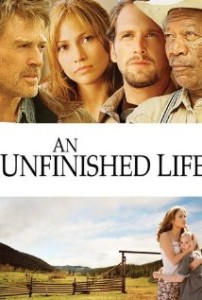What do we do with unseen pain?
How do we adjust to cruelties we must bear alone?
What toll does resentment take from a person’s willingness to take another step, to live another day?
Will we accept that the destination to life’s highway may take us down back roads before we come back to pavement again? When will we learn lessons right in front of us, waiting for application? Bearing with pain, coping with searing loss, Robert Redford’s movie explains how to live the rest of An Unfinished Life.
Director Lasse Hallstrom (whose films include What’s Eating Gilbert Grape?, Chocolat, and Cider House Rules) digs again beneath the surface, exposing the history of lives etched with fractured pain. The story rides along sentimental rails,[1] allowing Hallstrom to bring the train to station with little effort. Yet it is sometimes simple sentiment that lifts us. The ending may be formulaic but which of us hopes the finale won’t apply to us?
Viewers who understand abusive relationships will identify with Jean (Jennifer Lopez) as she seeks to escape one set of harms by running back to embrace old injuries. Einar (Robert Redford) is an unyielding flint of a man reopening past wounds daily to bath in their depressive spirits. Moral center in the cast is Mitch (Morgan Freeman). Freeman’s role reprises other “learned sage” credits (Robin Hood, Sum of All Fears, Seven, etc.) Bearing physical scars which ripple through his body, Mitch is able to look beyond the pain to spiritual release. The subtle inroads only a grandchild can manufacture are paved by child star talent Becca Gardner as Griff, Jean’s daughter. One would flinch to call Einar’s ranch a “home” to this rag-tag crew of misfits. Key to all relationships is that of Mitch with Einar. The restrained, yet forceful Western code of personal involvement in another’s life slowly soothes a raging spirit. It takes the intrusion of old hurts, however, to make the healing process complete.
Einar lives with regret. While the town has learned to live with Einar, Einar has yet to learn how to live with himself. Unable, unwilling to cross over his personal anger, he wallows in the memory of a past that cannot be changed. Ritualistically, daily Einar sits by a graveside, speaking to “What if?” instead of “What is?” Guilt crushes spirit and sinew under the Wyoming sun but forgiveness has universal healing properties.
Morgan Freeman delivers a line in another of his cinematic triumphs, The Shawshank Redemption, whose application serves well here: “Either get busy livin’ or get busy dyin’.” Time will go on with or without us. Human choice to overcome past pain is the only way to keep on living.
The lone question left to answer for the viewer is will we allow others to apply salve to places we cannot reach?
PG-13 for profanity, violence, suggestive dialogue, and adult situations.
Dr. Mark Eckel, Professor of Leadership, Education & Discipleship at Capital Seminary and Graduate School, enjoys reviewing films
[1] Mark Spragg, author of the novel An Unfinished Life, wrote the screenplay with his wife Virginia whose therapist background invades the script. Thankfully, seasoned actors rise above easy-answer-pop-psychology to wrest redemption from the reversals of life’s wrestling match.

